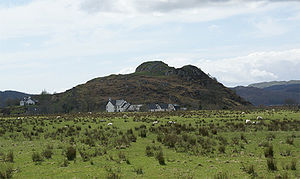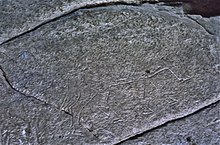396:
234:
408:
444:
468:
492:
480:
420:
432:
456:
35:
749:
384:," in which a modern-day woman is transported back to Dunadd's heyday in the 8th century. All the features of Dunadd, including the footprint, the boar, the well and the tumble down ruins are features of the story, as are the modern farm and cottages . Other ancient sites in the Kilmartin Valley also play a part in the narrative.
358:, and a number of artefacts from the early medieval period that were contemporary with Dunadd. Two medieval glass beads were found that have similar chemical compositions to those found at Dunadd, leading the archaeologists to believe that the beads came from Dunadd and that the site was associated with, or controlled by Dunadd.
225:. This no doubt increased the defensive potential of the site. Detailed analysis of sea-level changes in the region argue that the Dun was an island or promontory into historic times, and that receding sea levels left the fortification open to siege and seizure in the 6th to 7th centuries.
305:
The site was occupied after 736, at least into the 9th century. It is mentioned twice in later sources, suggesting that it retained some importance. In 1436, it is recorded that "Alan son of John
Riabhach MacLachlan of Dunadd" was made
333:
Because Dunadd is mentioned in early sources, and is readily identifiable, it has been excavated on several occasions (1904–1905, 1929, and 1980) and has one of the most important ensembles of finds from any early medieval site in
188:
and the
Scottish islands in the early centuries AD, possibly after the Romans had abandoned Southern Britain and at the time when the Anglo-Saxons were crossing the North Sea to counter incursions over
350:
Seven kilometres to the north of Dunadd is the site of Bruach An
Druimein. Excavated in the 1960s in advance of gravel quarrying, archaeologists discovered the remains of a Bronze Age
407:
376:
the Dal Riada undergo an internal struggle for control of royal succession, with Dun
Monaidh central to the conflict, including a depiction of royal coronation and use of
381:
784:
642:"Vol 27 (2008): Bruach An Druimein, Poltalloch, Argyll: excavations directed by the late Eric Cregeen, 1960-2 | Scottish Archaeological Internet Reports"
668:
769:
310:
of the lands of
Glassary; the chief place of residence of the MacLachlans of Dunadd lay below the fort. In June 1506, commissioners appointed by
395:
584:"Holocene Relative Sea-Level Changes in Western Scotland: The Early Insular Situation of Dun Add (Kintyre) and Dumbarton Rock (Strathclyde)"
789:
708:
809:
419:
804:
479:
431:
294:, king of the Picts, laid waste the territory of Dál Riata and seized Dún At and burned Creic and bound in chains two sons of
779:
491:
467:
700:
799:
794:
616:
540:
443:
455:
774:
50:
819:
342:, imported pottery and motif-pieces and moulds for the manufacture of fine metalwork (especially jewellery).
290:" without further comment on the outcome or participants. In the same chronicle the entry for 736 states: "
814:
672:
739:
372:
222:
291:
690:
217:(NR 836 936). The surrounding land, now largely reclaimed, was formerly boggy and known as the
676:
641:
314:, including the earl and bishop of Argyll, met at Dunadd to collect rents and resolve feuds.
299:
311:
295:
209:
Dunadd is a rocky crag that may have been one time an island and now lies inland near the
8:
233:
583:
413:
Dunadd Fort Basin and
Footprint, in Kilmichael Glassary in Argyll and Bute, Scotland
367:
322:
287:
190:
508:
377:
318:
282:
254:
338:. Finds range from the 6th to the 8th centuries AD. These include tools, weapons,
753:
355:
157:
139:
169:
763:
723:
710:
604:
250:
65:
52:
694:
214:
258:
246:
198:
173:
339:
262:
34:
669:
Three
Dimensional Modelling of Scottish Early Medieval Sculpted Stones
680:
307:
210:
146:
335:
242:
172:
period and is believed to be the capital of the ancient kingdom of
165:
161:
153:
325:, and is open to the public (open all year; no entrance charge).
181:
265:
ritual. On the same flat outcrop of rock is an incised boar in
185:
270:
266:
194:
177:
684:
351:
380:. Dunadd is the location for Claire R. McDougall's novel "
701:
Brief history with photos with respect to the Siol Alpin
280:
Dunadd is mentioned twice in early sources. In 683 the
237:
Pictish boar carving in rock near the top of the hill.
27:
Kilmichael
Glassary, Argyll, Scotland, United Kingdom
737:
437:
Extended view reverse of climb to top of Dunadd Fort
564:
562:
560:
558:
273:script. The inscription is read as referring to a
213:, from which it takes its name, a little north of
761:
555:
345:
785:Historic Scotland properties in Argyll and Bute
277:and is dated to the late 8th century or after.
245:, the site later became a seat of the kings of
286:record: "The siege of Dún At and the siege of
425:A View Of The River From The Summit Of Dunadd
687:format images of Dunadd and the surrounds.
257:and basin thought to have formed part of
485:Pathway carved through rocks near summit
461:Dunadd Hillfort - A View From The Summit
232:
770:Archaeological sites in Argyll and Bute
253:below the upper enclosure, including a
762:
581:
354:cemetery, two round houses from the
790:Former populated places in Scotland
13:
570:Dunadd: An early Dalriadic capital
14:
831:
810:Scotland in the Early Middle Ages
662:
497:Mid-level approach up steep slope
269:style, and an inscription in the
747:
530:, (Harper Collins, 1994) p. 255.
528:Collins Encyclopedia of Scotland
490:
478:
473:On site Descriptive Sign and Map
466:
454:
442:
430:
418:
406:
394:
33:
805:Scheduled monuments in Scotland
543:. Historic Environment Scotland
634:
609:
598:
582:Lathe, Richard; Smith, David,
575:
533:
520:
328:
249:. It is known for its unique
204:
180:kingdom spanning the northern
1:
568:Alan Lane and Ewan Campbell,
541:"Kilmartin Glen: Dunadd Fort"
361:
346:Bruach An Druimein connection
780:Landforms of Argyll and Bute
621:www.historicenvironment.scot
572:(Oxbow Books, Oxford, 2000).
7:
502:
241:Originally occupied in the
10:
836:
800:Iron Age sites in Scotland
795:Former islands of Scotland
526:John Keay and Julia Keay,
373:The Mark of the Horse Lord
228:
121:Iron age–16th century C.E.
125:
117:
112:
104:
94:
89:
81:
44:
32:
25:
20:
724:56.0859250°N 5.4784861°W
691:The Kingdom of the Gaels
673:Archaeology Data Service
514:
387:
646:journals.socantscot.org
449:A View From Atop Dunadd
775:Hill forts in Scotland
729:56.0859250; -5.4784861
238:
145:, "fort on the Add",
236:
820:Legendary footprints
697:- Scotland's History
605:The Annals of Ulster
321:, under the care of
292:Aengus son of Fergus
66:56.08611°N 5.47861°W
39:Dunadd Hillfort Crag
720: /
401:Footprint of Fealty
62: /
815:Cliffs of Scotland
239:
221:("Great Moor") in
176:. Dal Riata was a
164:, dating from the
71:56.08611; -5.47861
368:Rosemary Sutcliff
323:Historic Scotland
133:
132:
827:
752:
751:
750:
743:
735:
734:
732:
731:
730:
725:
721:
718:
717:
716:
713:
657:
656:
654:
652:
638:
632:
631:
629:
627:
613:
607:
602:
596:
595:
579:
573:
566:
553:
552:
550:
548:
537:
531:
524:
509:Petrosomatoglyph
494:
482:
470:
458:
446:
434:
422:
410:
398:
378:carved footprint
319:Ancient Monument
283:Annals of Ulster
90:Site information
77:
76:
74:
73:
72:
67:
63:
60:
59:
58:
55:
37:
28:
18:
17:
835:
834:
830:
829:
828:
826:
825:
824:
760:
759:
758:
748:
746:
738:
728:
726:
722:
719:
714:
711:
709:
707:
706:
665:
660:
650:
648:
640:
639:
635:
625:
623:
615:
614:
610:
603:
599:
580:
576:
567:
556:
546:
544:
539:
538:
534:
525:
521:
517:
505:
498:
495:
486:
483:
474:
471:
462:
459:
450:
447:
438:
435:
426:
423:
414:
411:
402:
399:
390:
364:
348:
331:
317:The site is an
302:and Feradach."
231:
207:
158:Argyll and Bute
140:Scottish Gaelic
97:the public
96:
70:
68:
64:
61:
56:
53:
51:
49:
48:
40:
26:
21:Dunadd Hillfort
12:
11:
5:
833:
823:
822:
817:
812:
807:
802:
797:
792:
787:
782:
777:
772:
757:
756:
704:
703:
698:
688:
664:
663:External links
661:
659:
658:
633:
608:
597:
588:The Heroic Age
574:
554:
532:
518:
516:
513:
512:
511:
504:
501:
500:
499:
496:
489:
487:
484:
477:
475:
472:
465:
463:
460:
453:
451:
448:
441:
439:
436:
429:
427:
424:
417:
415:
412:
405:
403:
400:
393:
389:
386:
370:'s 1965 novel
363:
360:
347:
344:
330:
327:
251:stone carvings
230:
227:
206:
203:
191:Hadrian's Wall
170:early medieval
131:
130:
127:
123:
122:
119:
115:
114:
110:
109:
106:
102:
101:
98:
92:
91:
87:
86:
83:
79:
78:
46:
42:
41:
38:
30:
29:
23:
22:
9:
6:
4:
3:
2:
832:
821:
818:
816:
813:
811:
808:
806:
803:
801:
798:
796:
793:
791:
788:
786:
783:
781:
778:
776:
773:
771:
768:
767:
765:
755:
745:
744:
741:
736:
733:
702:
699:
696:
692:
689:
686:
682:
678:
674:
670:
667:
666:
647:
643:
637:
622:
618:
617:"Dunadd Fort"
612:
606:
601:
593:
589:
585:
578:
571:
565:
563:
561:
559:
542:
536:
529:
523:
519:
510:
507:
506:
493:
488:
481:
476:
469:
464:
457:
452:
445:
440:
433:
428:
421:
416:
409:
404:
397:
392:
391:
385:
383:
379:
375:
374:
369:
359:
357:
353:
343:
341:
337:
326:
324:
320:
315:
313:
309:
303:
301:
297:
293:
289:
285:
284:
278:
276:
272:
268:
264:
260:
256:
252:
248:
244:
235:
226:
224:
220:
216:
212:
202:
200:
196:
192:
187:
183:
179:
175:
171:
167:
163:
159:
155:
151:
148:
144:
141:
137:
128:
124:
120:
116:
111:
107:
103:
99:
93:
88:
84:
80:
75:
47:
43:
36:
31:
24:
19:
16:
715:5°28′42.55″W
705:
695:BBC Scotland
649:. Retrieved
645:
636:
624:. Retrieved
620:
611:
600:
591:
587:
577:
569:
545:. Retrieved
535:
527:
522:
382:Veil of Time
371:
365:
349:
332:
316:
304:
281:
279:
274:
240:
218:
215:Lochgilphead
208:
149:
142:
135:
134:
113:Site history
95:Open to
15:
727: /
712:56°5′9.33″N
340:quernstones
329:Excavations
275:Finn Manach
205:Description
118:In use
69: /
45:Coordinates
764:Categories
547:23 October
362:In fiction
263:coronation
219:Mòine Mhòr
54:56°05′10″N
681:QuickTime
651:11 August
626:11 August
308:seneschal
288:Dún Duirn
259:Dál Riata
255:footprint
247:Dál Riata
211:River Add
199:Dalriadan
184:coast to
174:Dál Riata
147:Old Irish
126:Materials
105:Condition
57:5°28′43″W
754:Scotland
503:See also
356:Iron Age
336:Scotland
312:James IV
243:Iron Age
166:Iron Age
162:Scotland
154:hillfort
85:Hillfort
300:Donngal
298:, i.e.
296:Selbach
267:Pictish
229:History
201:Scots.
193:by the
152:) is a
150:Dún Att
740:Portal
223:Gaelic
186:Argyll
178:Gaelic
143:Dún Ad
136:Dunadd
594:: 1–5
515:Notes
388:Files
352:cists
271:ogham
195:Picts
182:Irish
129:Stone
685:VRML
683:and
653:2021
628:2021
549:2018
197:and
168:and
108:Ruin
82:Type
677:AVI
366:In
261:'s
156:in
100:Yes
766::
693:,
679:,
675:)
644:.
619:.
592:16
590:,
586:,
557:^
160:,
742::
671:(
655:.
630:.
551:.
138:(
Text is available under the Creative Commons Attribution-ShareAlike License. Additional terms may apply.

